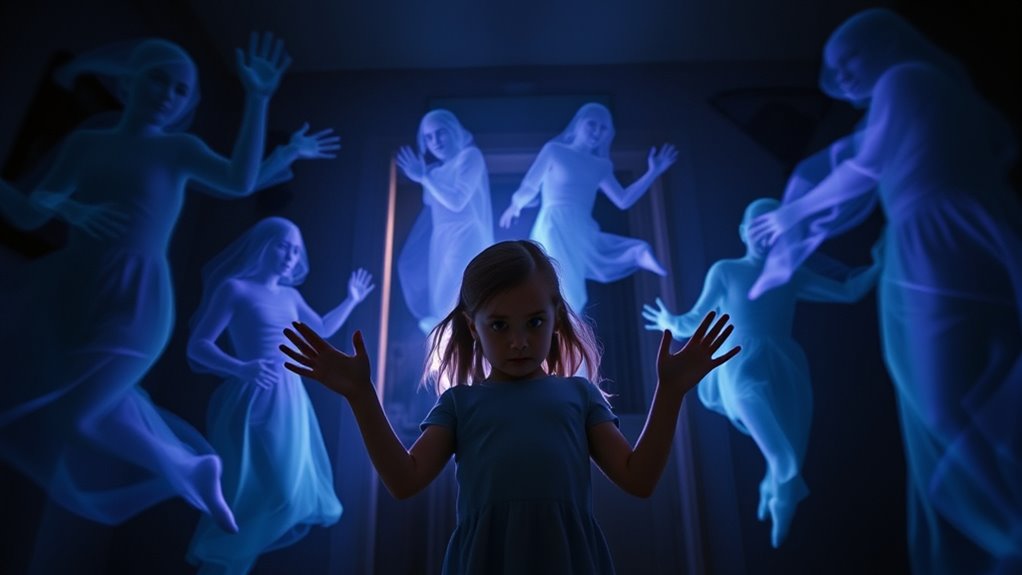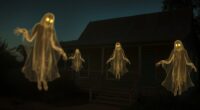In the Columbus Poltergeist case involving Tina Resch in 1984, psychological factors played a major role as her emotional stress and subconscious actions likely triggered many phenomena. Media coverage intensified the events, shaping perceptions and encouraging suggestibility among witnesses and Tina herself. Sensational reports fueled emotional reactions, creating a feedback loop that amplified the activity. If you look deeper, you’ll uncover how mind and media intertwined to influence this puzzling case.
Key Takeaways
- Tina Resch’s psychological stress and emotional turmoil likely contributed to the physical manifestations of the poltergeist.
- Media coverage in the 1980s amplified public perception and possibly influenced Tina’s behavior and witness reports.
- Suggestion and perception shaped by media portrayal played a significant role in how phenomena were interpreted and experienced.
- Sensationalized reporting heightened emotional reactions, potentially fueling ongoing activity and Tina’s involvement.
- The case exemplifies how psychological factors and media influence create a complex feedback loop affecting paranormal reports.

In 1974, residents of Columbus, Ohio, experienced a series of unexplained and intense poltergeist phenomena that baffled both skeptics and believers alike. As you delve into this case, you’ll notice that many experts consider psychological factors to be a significant piece of the puzzle. Tina Resch, a teenage girl at the center of the events, reportedly exhibited behaviors that many psychologists interpret as manifestations of subconscious stress or emotional turmoil. Such factors can lead to what’s called “motivated inaction,” where individuals unconsciously produce physical phenomena as a way of expressing internal conflicts. Tina’s age, family struggles, and teenage frustrations might have played roles in triggering her involvement in the poltergeist activity. This isn’t to dismiss the phenomena outright but to suggest that her mental state could have influenced or even initiated some of the displays.
Additionally, media influence played an essential role in shaping public perception and possibly even the unfolding of events. During the early 1980s, the media’s fascination with paranormal activity was at a high, and Tina’s case quickly garnered widespread attention. As coverage intensified, it’s likely that both Tina and those around her became increasingly aware of the narrative constructed about her. This heightened awareness could have led to a form of suggestion or expectation, where the media’s portrayal of poltergeists as supernatural entities influenced the way witnesses interpreted and responded to the phenomena. Media hype often amplifies the drama and heightens emotional reactions, which can, in turn, intensify the activity itself. You might consider how the media’s sensationalism created a feedback loop—encouraging Tina to behave in ways that fit the narrative of a haunted house, or causing witnesses to see and report phenomena that aligned with the popular ideas of poltergeist activity. Furthermore, research into psychological factors suggests that perception and suggestion can significantly influence reports of paranormal phenomena. Modern media influence has been shown to shape public perception and individual experiences related to unexplained events. Additionally, the role of sound and visual cues in media can heighten the sense of supernatural presence, further influencing perception.
Frequently Asked Questions
What Was Tina Resch’S Background Before the Poltergeist Incidents?
Before the poltergeist incidents, you might find Tina Resch’s family history and educational background interesting. She grew up in a supportive family environment, but there’s little detailed information about her early life. She was known to be intelligent and curious, with a decent educational background. Her upbringing may have influenced her later experiences, yet specifics about her childhood and education remain limited, leaving some questions unanswered about her early life.
Were There Any Similar Cases in the Same Neighborhood?
You might wonder if there are similar cases in the neighborhood history or local folklore. While specific incidents like Tina Resch’s are rare, many communities have stories of unexplained phenomena passed down through generations. These tales often reflect local beliefs and fears, creating a rich folklore. Although no exact parallels exist, such stories show how local history can influence perceptions of paranormal activity in the area.
How Did Media Coverage Influence Public Perception of the Case?
You see how media sensationalism can shape public perception, making people more intrigued or skeptical. For instance, in the Columbus Poltergeist case, headlines exaggerated supernatural claims, fueling belief and fear. This coverage often heightened public skepticism, as skeptics questioned the authenticity of the events. Media’s portrayal influences whether the public perceives the case as genuine or hoax, demonstrating its powerful role in shaping societal reactions to paranormal phenomena.
What Psychological Factors Might Have Contributed to Tina’S Behavior?
You might consider that suggestibility played a role in Tina’s behavior, as her responses could have been influenced by her environment and expectations. Additionally, emotional trauma from her family life could have heightened her susceptibility to certain actions or expressions of distress. These psychological factors may have contributed to her apparent involuntary movements or reactions, making her behavior seem more extraordinary than it truly was.
Were Any Scientific Tests Conducted to Verify Supernatural Activity?
You might wonder if any experimental tests or scientific verification confirmed supernatural activity. Researchers did conduct specific experiments, like monitoring Tina’s behavior and testing for physical anomalies. However, these tests often failed to produce conclusive evidence, raising doubts about supernatural explanations. While some claimed to observe unexplained phenomena, scientific verification remains elusive, leaving the question open whether Tina’s experiences were genuinely paranormal or explained by psychological and environmental factors.
Conclusion
As you reflect on the Columbus Poltergeist, you realize it’s like a swirling storm of mystery and fear, impossible to ignore. The case leaves you questioning what’s real and what’s illusion, stirring your curiosity just as Tina Resch’s unexplained phenomena did. Whether supernatural or psychological, this case reminds you that some mysteries are like shadows—forever lurking just beyond understanding, beckoning you to explore further. You’re left wondering what secrets lie beneath the surface of our everyday lives.









